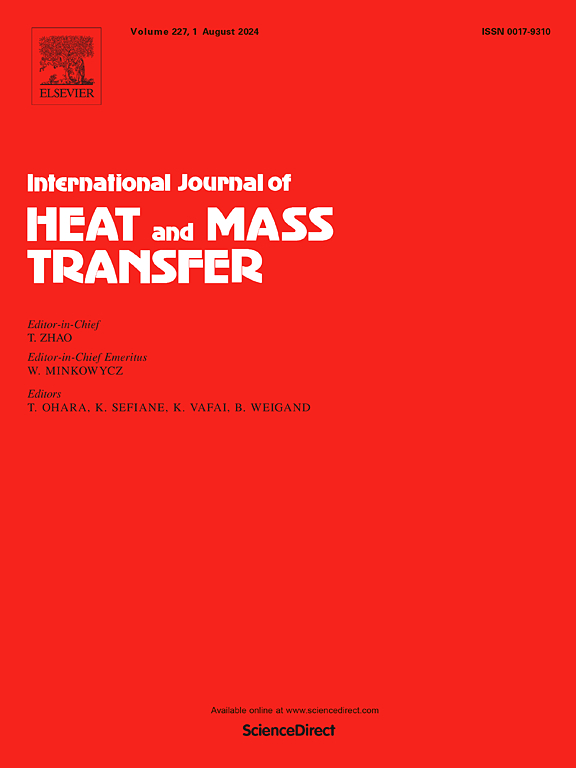Subchannel-averaged void fraction covariance and relative velocity covariance for steam-water boiling flows in NUPEC type I and type II bundles
IF 5.8
2区 工程技术
Q1 ENGINEERING, MECHANICAL
International Journal of Heat and Mass Transfer
Pub Date : 2025-04-26
DOI:10.1016/j.ijheatmasstransfer.2025.127154
引用次数: 0
Abstract
In subchannel analysis codes, constitutive correlations for subchannel-averaged void fraction covariance and relative velocity covariance are essential to account for the effects of non-uniform void fraction distribution on the subchannel-averaged relative velocity between gas and liquid phases. In this study, NUPEC (Nuclear Power Engineering Center) rod bundle data measured using X-ray CT were processed with a noise-removal method to obtain subchannel-averaged void fraction covariance and relative velocity covariance data for boiling two-phase flows. The experiments covered pressure ranges from 0.981 MPa to 8.63 MPa, with subchannel-averaged void fractions ranging from 0.1 to 0.8. The void fraction covariance in different subchannels decreased with increasing subchannel-averaged void fraction. Meanwhile, the relative velocity covariance initially increased and then decreased as the subchannel-averaged void fraction increased. Across the experimental pressure range, pressure effects on subchannel-averaged void fraction covariance and relative velocity covariance were minimal. Correlations for subchannel-averaged void fraction covariance and relative velocity covariance were developed based on the experimental data. For interior, edge, and corner subchannels, the mean absolute relative deviations between the proposed correlations and the experimental data were within 2.0 %, demonstrating the high accuracy of the correlations. These correlations were also validated for subchannels in a rod bundle containing a large water rod, yielding mean absolute relative deviations within 1.5 % for the interior, edge, and corner subchannels.
NUPEC I型和II型束蒸汽-水沸腾流的子通道平均空隙率协方差和相对速度协方差
在子通道分析代码中,子通道平均孔隙分数协方差和相对速度协方差的本构关系对于解释气液两相间非均匀孔隙分数分布对子通道平均相对速度的影响至关重要。本研究利用x射线CT测量的NUPEC(核电工程中心)棒束数据,采用去噪方法进行处理,得到沸腾两相流的子通道平均空隙率协方差和相对速度协方差数据。实验压力范围为0.981 MPa ~ 8.63 MPa,子通道平均孔隙分数范围为0.1 ~ 0.8。随着子通道平均空隙率的增大,各子通道空隙率的协方差减小。同时,相对速度协方差随子通道平均空隙率的增大先增大后减小。在整个实验压力范围内,压力对子通道平均空隙率协方差和相对速度协方差的影响最小。根据实验数据,建立了子通道平均空隙率协方差和相对速度协方差的相关关系。对于内部、边缘和角子通道,所提出的相关性与实验数据之间的平均绝对相对偏差在2.0%以内,表明相关性具有较高的准确性。这些相关性也在包含大水棒的杆束中的子通道中得到了验证,对于内部、边缘和角落的子通道,平均绝对相对偏差在1.5%以内。
本文章由计算机程序翻译,如有差异,请以英文原文为准。
求助全文
约1分钟内获得全文
求助全文
来源期刊
CiteScore
10.30
自引率
13.50%
发文量
1319
审稿时长
41 days
期刊介绍:
International Journal of Heat and Mass Transfer is the vehicle for the exchange of basic ideas in heat and mass transfer between research workers and engineers throughout the world. It focuses on both analytical and experimental research, with an emphasis on contributions which increase the basic understanding of transfer processes and their application to engineering problems.
Topics include:
-New methods of measuring and/or correlating transport-property data
-Energy engineering
-Environmental applications of heat and/or mass transfer

 求助内容:
求助内容: 应助结果提醒方式:
应助结果提醒方式:


